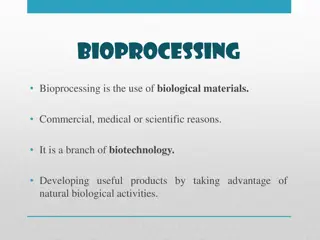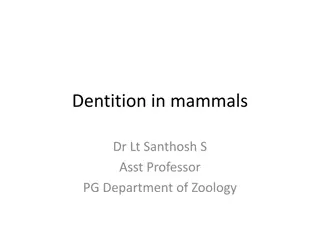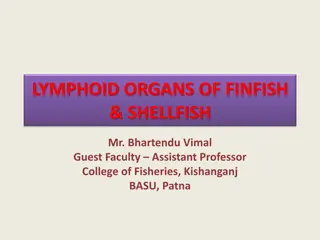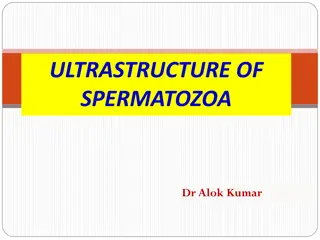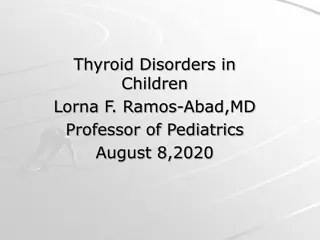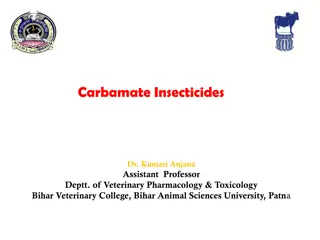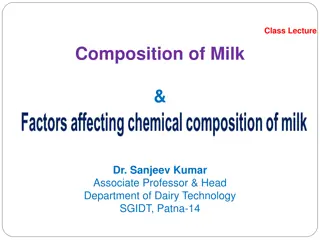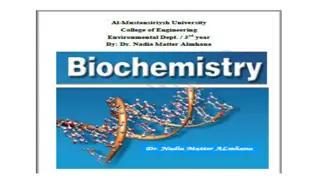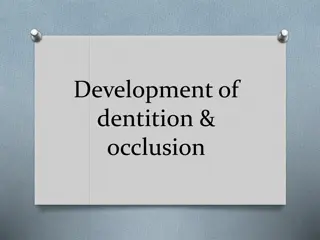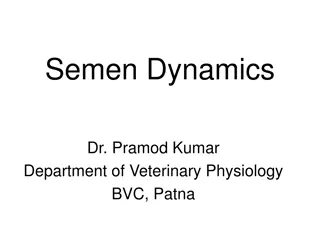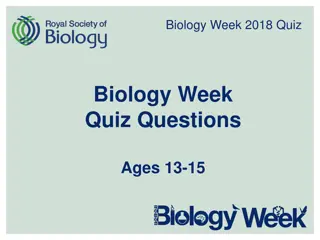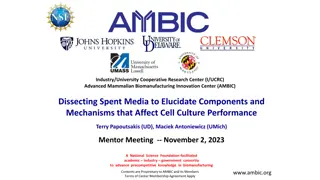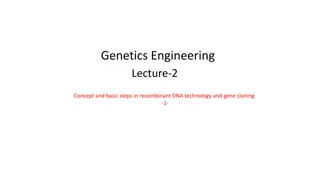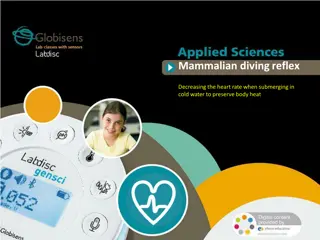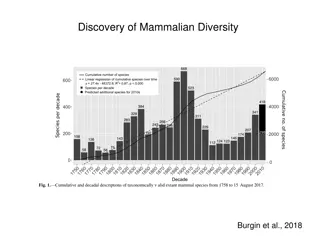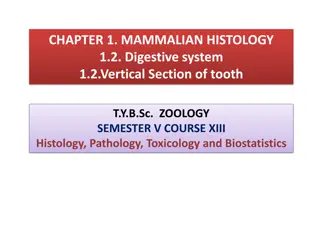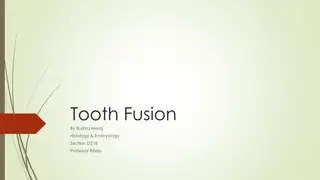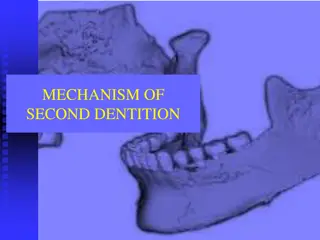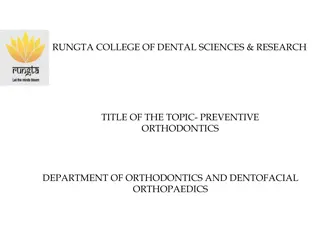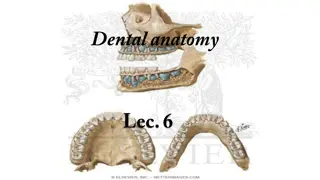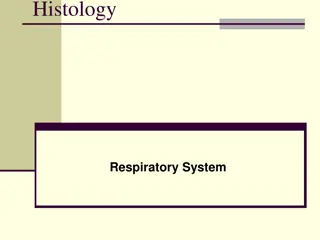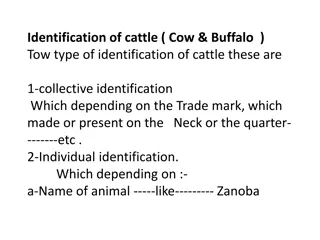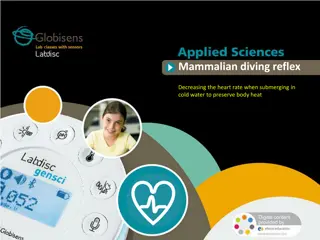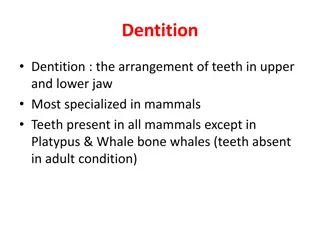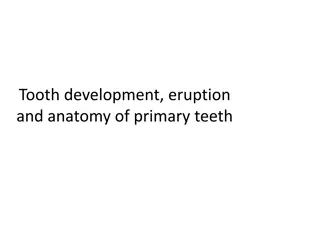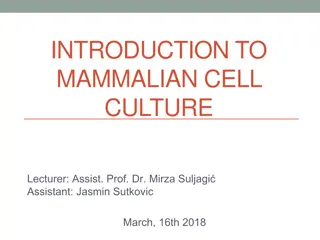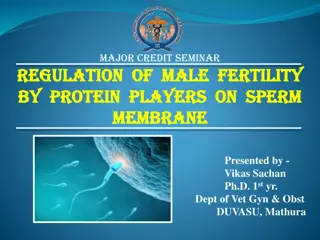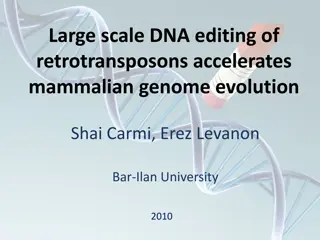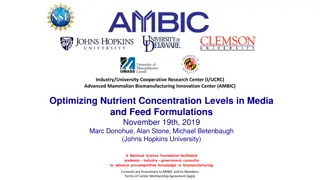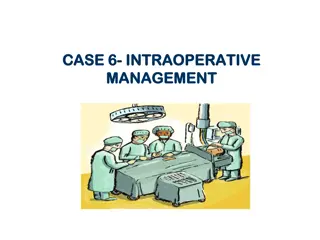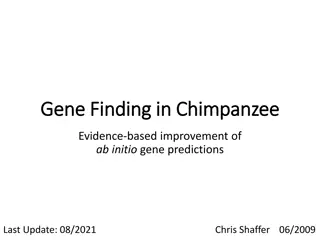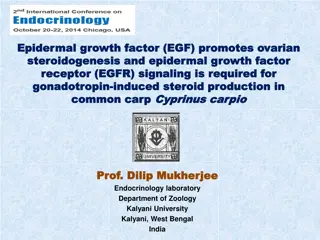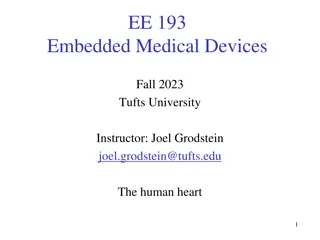The Development of Occlusion and Dentition
Exploring the stages of tooth development, eruption, theories, and keys to normal occlusion. Learn about primary and permanent dentition, dental formulae, dental lamina, odontogenic cells, and enamel organ formation in the process of tooth development.
6 views • 108 slides
Protein Expression Market
Protein Expression Market by System (Mammalian [CHO, HEK 293], Non-mammalian [Bacterial, Insect, Yeast]), Offering (Kits & Reagents, Vectors, Competent Cells, Services), Application (Industrial, Therapeutic, Research), and End User - Global Forecast to 2030\n\n
4 views • 4 slides
Regulation of Energy Homeostasis by AMPK System and Its Modulation Factors
The AMPK system plays a crucial role in regulating energy homeostasis by sensing the cellular AMP:ATP ratio and responding to metabolic stresses that affect ATP production or consumption. AMPK is activated by factors such as hypoxia, glucose deprivation, and metabolic inhibitors, as well as by compo
0 views • 27 slides
Bioprocessing: Advantages, History, Applications, and Enzyme Use
Bioprocessing utilizes biological materials for commercial, medical, and scientific purposes, leveraging natural biological activities to develop useful products. This branch of biotechnology offers advantages such as low temperature, pressure, and pH requirements, along with renewable resources for
2 views • 11 slides
Mammalian Dentition and Tooth Structure Exploration
Understanding dentition in mammals sheds light on their evolution, classification, age approximation, and dietary habits. The arrangement of teeth, tooth structure, development, and types of mammalian teeth are discussed, highlighting unique features like thecodont attachment, enamel coating, and de
3 views • 16 slides
Overview of Lymphoid Organs in Finfish and Shellfish
Lymphoid organs play a crucial role in the defense mechanisms of finfish and shellfish by generating immune cells. Different types of fish vary in their lymphoid organ structures, with jawless fish relying on lymphoid tissue within other organs for immune cell production. Cyclostomes, like hagfish a
1 views • 24 slides
Ultrastructure of Spermatozoa and Their Components
Explore the intricate details of spermatozoa and their structures, including the head, nucleus, acrosome, and more. Learn about the dimensions of mammalian spermatozoa and the principal parts that make up these essential reproductive cells.
0 views • 23 slides
Thyroid Disorders in Children - Clinical Case Study
This clinical case study focuses on a pediatric patient presenting with abdominal enlargement and a history of delayed development. Key aspects covered include birth and maternal history, immediate postnatal course, developmental milestones, and past medical history. The diagnosis process involves c
0 views • 56 slides
Carbamate Insecticides: Classification, Mechanism of Action, Clinical Signs, and Treatment
Carbamate insecticides are widely used in agricultural and veterinary practices due to their broad-spectrum activity and low mammalian toxicity. This chapter discusses the classification, similarities with organophosphate compounds, differences, mechanism of action, clinical signs, diagnosis, and tr
1 views • 13 slides
The Composition of Milk by Dr. Sanjeev Kumar
Milk, a vital substance for mammalian offspring, is a complex fluid composed of water, fat, protein, lactose, minerals, vitamins, and enzymes. Dr. Sanjeev Kumar, an Associate Professor and Head of the Department of Dairy Technology at SGIDT, enlightens us on the various constituents of milk, market
0 views • 11 slides
Amino Acids: Qualitative Tests and Properties
Amino acids play a crucial role as building blocks of proteins and can be converted into specialized products. There are 20 common L-α-amino acids found in mammalian proteins, each with a unique structure and classification based on their side chain properties. Amino acids exhibit optical activity,
1 views • 34 slides
Structure and Role of Amino Acids in Proteins
Amino acids are building blocks of proteins, with distinct structures and properties. There are 20 common amino acids found in mammalian proteins, each with a carboxyl group, an amino group, and a unique side chain. The side chains determine the role of an amino acid in a protein, classified as nonp
10 views • 11 slides
The Development of Dentition and Occlusion
Explore the fascinating journey of tooth development from the oral octoderm to the various stages of dentition, including the bud, cap, and bell stages. Learn about root development and the formation of the Hertwig's epithelial root sheath. Discover key features of the pre-dentate period and the dec
2 views • 38 slides
Semen Dynamics and Capacitation in Mammalian Spermatozoa
Semen dynamics play a crucial role in mammalian reproduction, with capacitation being a key process for sperm fertilization capability. Capacitation involves physiological changes in sperm, leading to the acrosome reaction, crucial for oocyte penetration. As sperm transit through the epididymis, the
5 views • 13 slides
Biology Week 2018 Quiz for Ages 13-15
Test your knowledge with this engaging Biology Week 2018 quiz designed for ages 13-15. The quiz includes questions on various topics such as fungi, cow anatomy, famous scientists, plant cell structures, endocrinology, atmosphere composition, mammalian reproduction, DNA similarity, animal groups, and
2 views • 22 slides
Advancements in Cell Culture Performance Optimization Through Dissecting Spent Media
The Industry/University Cooperative Research Center (I/UCRC) Advanced Mammalian Biomanufacturing Innovation Center (AMBIC) is focusing on dissecting spent media to understand the components affecting cell culture performance. The project aims to identify growth-promoting and inhibiting factors in sp
0 views • 16 slides
Cloning Vectors and Recombinant DNA Technology
Genetics Engineering Lecture-2 delves into the concept and basic steps of recombinant DNA technology and gene cloning, highlighting different types of cloning vectors like plasmids, bacteriophages, bacterial artificial chromosomes, yeast artificial chromosomes, and mammalian artificial chromosomes.
1 views • 13 slides
Immune Responses to Parasitic Infections and Evasive Strategies by Protozoan and Helminth Parasites
Parasitic infections pose complex challenges to the immune system due to the diverse nature of parasites, including protozoans and helminths. Protozoan parasites move between arthropod vectors and mammalian hosts, requiring both humoral and cell-mediated immune responses. Meanwhile, helminths, as mu
0 views • 15 slides
Mammalian Diving Reflex
Delve into the fascinating adaptation of the mammalian diving reflex, where heart rate decreases when submerged in cold water to conserve body heat. Understand the evolutionary history, theory, and physiological changes involved in this reflex through an engaging experiment. Discover the sensations
0 views • 20 slides
Fascinating Discoveries in Mammalian Diversity
Recent scientific findings have unveiled new species of mammals like the gymure Podogymnura intermedia in the Philippines and chipmunks Tamias cratericus and T. grisescens. Notably, the discovery of Rice's whale highlights the critical condition of this species. The evolution and varied characterist
0 views • 28 slides
Mammalian Tooth Structure: Vertical Section Overview
Mammalian teeth consist of hard tissues (enamel, dentine, cementum) and soft tissue (tooth pulp). The enamel is the hardest, dentine surrounds the pulp cavity, and cementum covers the dentine and connects to the alveolar bone. Tooth pulp provides support, nourishment, and defense mechanisms. Support
1 views • 7 slides
Tooth Fusion in Dentistry
Tooth fusion is the merging of two tooth germs into a single large crown, which can be complete or incomplete depending on the developmental stage. It can affect primary dentition, mostly incisors and canines. Differentiating fusion from gemination involves examining the pulp chambers. Causes may in
0 views • 9 slides
The Mechanism of Second Dentition in Humans
Second dentition is a natural process involving the development of a second set of teeth in humans. This complex phenomenon includes factors like root development, periodontal changes, and functional occlusion. The process is crucial for normal craniofacial development and has implications for ortho
0 views • 24 slides
Preventive Orthodontics in Dental Sciences Research
Preventive orthodontics in the Department of Orthodontics and Dentofacial Orthopedics involves educating patients and parents, controlling caries, managing deciduous dentition, and more to preserve normal occlusion. Procedures include patient education, caries control, and care of deciduous dentitio
0 views • 26 slides
Characteristics of Mandibular Incisors in Permanent Dentition
Mandibular incisors in the permanent dentition are unique with 2 centrals and 2 laterals, featuring smaller dimensions and specific anatomical characteristics such as incisal ridge inclinations, lingual surface smoothness, root grooves, and distinct crown outlines. The morphology of these teeth diff
0 views • 13 slides
Overview of Mammalian Respiratory System Histology
The respiratory system in mammals functions to warm, humidify, and cleanse the air as it travels from the nostrils to the lungs. It comprises the nasal cavity, pharynx, larynx, trachea, bronchi, and bronchial tree. The epithelial linings vary in different parts, containing specialized cells and glan
0 views • 14 slides
Cattle Identification Methods and Characteristics Explained
Explore different methods of identifying cattle including collective and individual methods such as branding, tattooing, and tagging. Learn about cattle species, breeds, colors, and aging factors like dentition and parturition. Discover the main color variations in cattle such as yellow, red, black,
0 views • 36 slides
The Mammalian Diving Reflex
Explore the mammalian diving reflex, a fascinating adaptation seen in marine mammals and humans when submerged in cold water. This reflex involves a decrease in heart rate to conserve body heat, allowing for extended breath-holding. Through experiments, learn how the body reacts to underwater condit
0 views • 21 slides
Mammalian Dentition and Tooth Structure
Dentition refers to the arrangement of teeth in the upper and lower jaw of mammals. Most mammals have specialized teeth, with some exceptions like the Platypus and Baleen whales. The structure of a mammalian tooth includes the crown, root, and neck, made up of dentine, enamel, and cement. Tooth deve
0 views • 13 slides
Primary Tooth Development and Eruption
Explore the stages of tooth development and eruption in primary teeth, from induction to eruption, with details on mineralization, eruption times, symptoms, disturbances, and primary dentition characteristics. Learn about common issues and the relationship between primary teeth and permanent teeth.
0 views • 12 slides
Basics of Mammalian Cell Culture
Mammalian cell culture involves the removal of cells from an organism for growth in a controlled environment. Primary cell cultures can be sub-cultured, leading to the generation of cell lines. Sub-culturing involves transferring cells to fresh growth media for further growth. Different methods and
0 views • 29 slides
Protein Players in Male Fertility Regulation
Cooperative interactions between proteins on sperm membranes play a crucial role in male fertility regulation, affecting sperm migration, binding to the oviduct, and successful fertilization. Understanding these protein factors is essential for comprehending the complex process of mammalian fertiliz
0 views • 62 slides
DNA Editing of Retrotransposons and Mammalian Genome Evolution
Large-scale DNA editing of retrotransposons plays a crucial role in accelerating mammalian genome evolution. Retrotransposons, accounting for half of the human genome, are mobile elements that can lead to mutations and genetic disorders but also serve as a reservoir for genetic innovation, rewiring
0 views • 26 slides
Advanced Mammalian Biomanufacturing Innovation Center Overview
This content provides insights into the ongoing research and experimental updates at the Advanced Mammalian Biomanufacturing Innovation Center (AMBIC) of Johns Hopkins University. The focus is on optimizing nutrient concentration levels in media and feed formulations through experimental processes s
0 views • 21 slides
Milk Clotting Enzymes - Rennet and Cheese Making Process
Milk clotting enzymes, such as rennet, play a crucial role in cheese making through enzymatic coagulation of milk. Rennet is a complex mixture of enzymes found in mammalian stomachs, particularly in the fourth stomach chamber of young calves. The main enzyme in rennet, chymosin or rennin, coagulates
0 views • 6 slides
Intraoperative Management of 4-Year-Old Male Patient for Eye Squint Surgery
Assessing a 4-year-old boy scheduled for eye squint surgery involves evaluating family history, dentition, airway considerations, and preoperative tests. Factors like obesity, OSA, previous illnesses, and medications play a crucial role in determining perioperative risk. Maintaining communication wi
0 views • 22 slides
Enhancing Gene Predictions Based on Chimpanzee Genomic Analysis
Dive into evidence-based improvement of gene predictions in chimpanzees, focusing on ab initio predictions and utilizing various computational and cognitive skills to annotate mammalian genomes. Explore basic gene structures, motif information, and strategies to refine gene models for accurate annot
0 views • 28 slides
EGF Role in Ovarian Steroidogenesis
The role of Epidermal Growth Factor (EGF) and its receptor (EGFR) in promoting ovarian steroidogenesis and signaling pathways in common carp. EGF's interaction with gonadotropins and its impact on steroid production, including progesterone and FSH-induced estradiol production, are explored. Studies
0 views • 30 slides
Epidermal Growth Factor in Ovarian Steroidogenesis
The function of Epidermal Growth Factor (EGF) in promoting ovarian steroidogenesis and signaling pathways induced by gonadotropins, essential for understanding its role in the process. Studies have shown EGF's impact on steroid production in common carp and its influence on granulosa cell differenti
0 views • 28 slides
Embedded Medical Devices - Understanding the Human Heart
Dive into the fascinating world of embedded medical devices with a focus on the intricate workings of the human heart. Explore cardiac facts, ECG measurement, heart disease statistics, and the engineering marvel that is the mammalian heart. Discover the complexities of heart attacks, cardiac arrests
0 views • 62 slides



